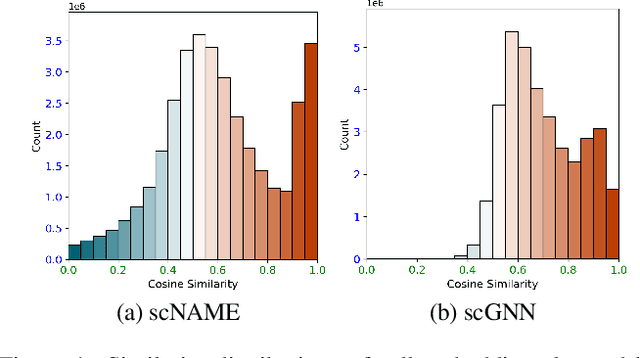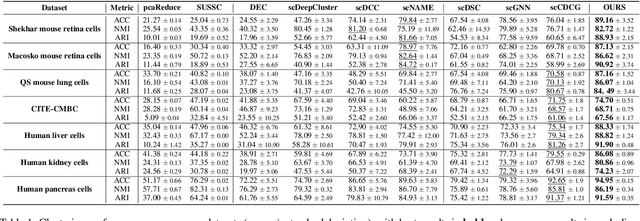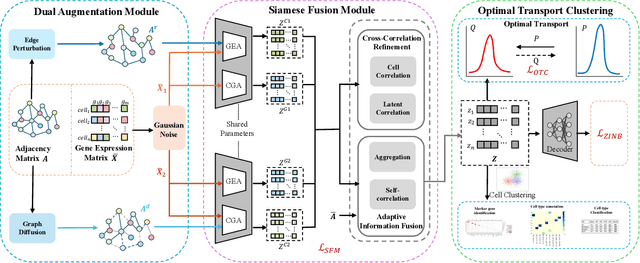Pengfei Wang
School of Computer Science and Engineering, Central South University, Changsha, China
Frozen LVLMs for Micro-Video Recommendation: A Systematic Study of Feature Extraction and Fusion
Dec 26, 2025Abstract:Frozen Large Video Language Models (LVLMs) are increasingly employed in micro-video recommendation due to their strong multimodal understanding. However, their integration lacks systematic empirical evaluation: practitioners typically deploy LVLMs as fixed black-box feature extractors without systematically comparing alternative representation strategies. To address this gap, we present the first systematic empirical study along two key design dimensions: (i) integration strategies with ID embeddings, specifically replacement versus fusion, and (ii) feature extraction paradigms, comparing LVLM-generated captions with intermediate decoder hidden states. Extensive experiments on representative LVLMs reveal three key principles: (1) intermediate hidden states consistently outperform caption-based representations, as natural-language summarization inevitably discards fine-grained visual semantics crucial for recommendation; (2) ID embeddings capture irreplaceable collaborative signals, rendering fusion strictly superior to replacement; and (3) the effectiveness of intermediate decoder features varies significantly across layers. Guided by these insights, we propose the Dual Feature Fusion (DFF) Framework, a lightweight and plug-and-play approach that adaptively fuses multi-layer representations from frozen LVLMs with item ID embeddings. DFF achieves state-of-the-art performance on two real-world micro-video recommendation benchmarks, consistently outperforming strong baselines and providing a principled approach to integrating off-the-shelf large vision-language models into micro-video recommender systems.
Reasoning-Style Poisoning of LLM Agents via Stealthy Style Transfer: Process-Level Attacks and Runtime Monitoring in RSV Space
Dec 16, 2025Abstract:Large Language Model (LLM) agents relying on external retrieval are increasingly deployed in high-stakes environments. While existing adversarial attacks primarily focus on content falsification or instruction injection, we identify a novel, process-oriented attack surface: the agent's reasoning style. We propose Reasoning-Style Poisoning (RSP), a paradigm that manipulates how agents process information rather than what they process. We introduce Generative Style Injection (GSI), an attack method that rewrites retrieved documents into pathological tones--specifically "analysis paralysis" or "cognitive haste"--without altering underlying facts or using explicit triggers. To quantify these shifts, we develop the Reasoning Style Vector (RSV), a metric tracking Verification depth, Self-confidence, and Attention focus. Experiments on HotpotQA and FEVER using ReAct, Reflection, and Tree of Thoughts (ToT) architectures reveal that GSI significantly degrades performance. It increases reasoning steps by up to 4.4 times or induces premature errors, successfully bypassing state-of-the-art content filters. Finally, we propose RSP-M, a lightweight runtime monitor that calculates RSV metrics in real-time and triggers alerts when values exceed safety thresholds. Our work demonstrates that reasoning style is a distinct, exploitable vulnerability, necessitating process-level defenses beyond static content analysis.
Dual-Phase Federated Deep Unlearning via Weight-Aware Rollback and Reconstruction
Dec 15, 2025Abstract:Federated Unlearning (FUL) focuses on client data and computing power to offer a privacy-preserving solution. However, high computational demands, complex incentive mechanisms, and disparities in client-side computing power often lead to long times and higher costs. To address these challenges, many existing methods rely on server-side knowledge distillation that solely removes the updates of the target client, overlooking the privacy embedded in the contributions of other clients, which can lead to privacy leakage. In this work, we introduce DPUL, a novel server-side unlearning method that deeply unlearns all influential weights to prevent privacy pitfalls. Our approach comprises three components: (i) identifying high-weight parameters by filtering client update magnitudes, and rolling them back to ensure deep removal. (ii) leveraging the variational autoencoder (VAE) to reconstruct and eliminate low-weight parameters. (iii) utilizing a projection-based technique to recover the model. Experimental results on four datasets demonstrate that DPUL surpasses state-of-the-art baselines, providing a 1%-5% improvement in accuracy and up to 12x reduction in time cost.
DeepGo: Predictive Directed Greybox Fuzzing
Jul 29, 2025Abstract:The state-of-the-art DGF techniques redefine and optimize the fitness metric to reach the target sites precisely and quickly. However, optimizations for fitness metrics are mainly based on heuristic algorithms, which usually rely on historical execution information and lack foresight on paths that have not been exercised yet. Thus, those hard-to-execute paths with complex constraints would hinder DGF from reaching the targets, making DGF less efficient. In this paper, we propose DeepGo, a predictive directed grey-box fuzzer that can combine historical and predicted information to steer DGF to reach the target site via an optimal path. We first propose the path transition model, which models DGF as a process of reaching the target site through specific path transition sequences. The new seed generated by mutation would cause the path transition, and the path corresponding to the high-reward path transition sequence indicates a high likelihood of reaching the target site through it. Then, to predict the path transitions and the corresponding rewards, we use deep neural networks to construct a Virtual Ensemble Environment (VEE), which gradually imitates the path transition model and predicts the rewards of path transitions that have not been taken yet. To determine the optimal path, we develop a Reinforcement Learning for Fuzzing (RLF) model to generate the transition sequences with the highest sequence rewards. The RLF model can combine historical and predicted path transitions to generate the optimal path transition sequences, along with the policy to guide the mutation strategy of fuzzing. Finally, to exercise the high-reward path transition sequence, we propose the concept of an action group, which comprehensively optimizes the critical steps of fuzzing to realize the optimal path to reach the target efficiently.
GLAD: Generalizable Tuning for Vision-Language Models
Jul 17, 2025Abstract:Pre-trained vision-language models, such as CLIP, show impressive zero-shot recognition ability and can be easily transferred to specific downstream tasks via prompt tuning, even with limited training data. However, existing prompt tuning methods face two main challenges: (1) In few-shot scenarios, data scarcity often leads to overfitting, making the model sensitive to changes in the input domain. (2) To mitigate overfitting, these methods typically rely on complex task-specific model architectures and sensitive hyperparameter tuning, severely restricting their general applicability. To address these issues, we propose a simpler and more general framework called GLAD (Generalizable LoRA tuning with RegulArized GraDient). We show that merely applying LoRA achieves performance in downstream tasks comparable to current state-of-the-art prompt-based methods. While LoRA is effective and easy to use, it remains susceptible to overfitting in few-shot learning scenarios. To mitigate this risk, we introduce a gradient-based regularization technique. This technique effectively steers the optimization trajectory, encouraging the model to find a more stable parameter region that is robust to variations in data distribution. Through extensive experiments conducted on 15 benchmark datasets, we demonstrate that GLAD outperforms previous tuning approaches in terms of base-to-novel class generalization, image domain generalization, and cross-dataset generalization. The code will be publicly available.
NeuVAS: Neural Implicit Surfaces for Variational Shape Modeling
Jun 16, 2025Abstract:Neural implicit shape representation has drawn significant attention in recent years due to its smoothness, differentiability, and topological flexibility. However, directly modeling the shape of a neural implicit surface, especially as the zero-level set of a neural signed distance function (SDF), with sparse geometric control is still a challenging task. Sparse input shape control typically includes 3D curve networks or, more generally, 3D curve sketches, which are unstructured and cannot be connected to form a curve network, and therefore more difficult to deal with. While 3D curve networks or curve sketches provide intuitive shape control, their sparsity and varied topology pose challenges in generating high-quality surfaces to meet such curve constraints. In this paper, we propose NeuVAS, a variational approach to shape modeling using neural implicit surfaces constrained under sparse input shape control, including unstructured 3D curve sketches as well as connected 3D curve networks. Specifically, we introduce a smoothness term based on a functional of surface curvatures to minimize shape variation of the zero-level set surface of a neural SDF. We also develop a new technique to faithfully model G0 sharp feature curves as specified in the input curve sketches. Comprehensive comparisons with the state-of-the-art methods demonstrate the significant advantages of our method.
DreamActor-H1: High-Fidelity Human-Product Demonstration Video Generation via Motion-designed Diffusion Transformers
Jun 12, 2025Abstract:In e-commerce and digital marketing, generating high-fidelity human-product demonstration videos is important for effective product presentation. However, most existing frameworks either fail to preserve the identities of both humans and products or lack an understanding of human-product spatial relationships, leading to unrealistic representations and unnatural interactions. To address these challenges, we propose a Diffusion Transformer (DiT)-based framework. Our method simultaneously preserves human identities and product-specific details, such as logos and textures, by injecting paired human-product reference information and utilizing an additional masked cross-attention mechanism. We employ a 3D body mesh template and product bounding boxes to provide precise motion guidance, enabling intuitive alignment of hand gestures with product placements. Additionally, structured text encoding is used to incorporate category-level semantics, enhancing 3D consistency during small rotational changes across frames. Trained on a hybrid dataset with extensive data augmentation strategies, our approach outperforms state-of-the-art techniques in maintaining the identity integrity of both humans and products and generating realistic demonstration motions. Project page: https://submit2025-dream.github.io/DreamActor-H1/.
Distilling Closed-Source LLM's Knowledge for Locally Stable and Economic Biomedical Entity Linking
May 26, 2025Abstract:Biomedical entity linking aims to map nonstandard entities to standard entities in a knowledge base. Traditional supervised methods perform well but require extensive annotated data to transfer, limiting their usage in low-resource scenarios. Large language models (LLMs), especially closed-source LLMs, can address these but risk stability issues and high economic costs: using these models is restricted by commercial companies and brings significant economic costs when dealing with large amounts of data. To address this, we propose ``RPDR'', a framework combining closed-source LLMs and open-source LLMs for re-ranking candidates retrieved by a retriever fine-tuned with a small amount of data. By prompting a closed-source LLM to generate training data from unannotated data and fine-tuning an open-source LLM for re-ranking, we effectively distill the knowledge to the open-source LLM that can be deployed locally, thus avoiding the stability issues and the problem of high economic costs. We evaluate RPDR on two datasets, including one real-world dataset and one publicly available dataset involving two languages: Chinese and English. RPDR achieves 0.019 Acc@1 improvement and 0.036 Acc@1 improvement on the Aier dataset and the Ask A Patient dataset when the amount of training data is not enough. The results demonstrate the superiority and generalizability of the proposed framework.
scSiameseClu: A Siamese Clustering Framework for Interpreting single-cell RNA Sequencing Data
May 19, 2025



Abstract:Single-cell RNA sequencing (scRNA-seq) reveals cell heterogeneity, with cell clustering playing a key role in identifying cell types and marker genes. Recent advances, especially graph neural networks (GNNs)-based methods, have significantly improved clustering performance. However, the analysis of scRNA-seq data remains challenging due to noise, sparsity, and high dimensionality. Compounding these challenges, GNNs often suffer from over-smoothing, limiting their ability to capture complex biological information. In response, we propose scSiameseClu, a novel Siamese Clustering framework for interpreting single-cell RNA-seq data, comprising of 3 key steps: (1) Dual Augmentation Module, which applies biologically informed perturbations to the gene expression matrix and cell graph relationships to enhance representation robustness; (2) Siamese Fusion Module, which combines cross-correlation refinement and adaptive information fusion to capture complex cellular relationships while mitigating over-smoothing; and (3) Optimal Transport Clustering, which utilizes Sinkhorn distance to efficiently align cluster assignments with predefined proportions while maintaining balance. Comprehensive evaluations on seven real-world datasets demonstrate that~\methodname~outperforms state-of-the-art methods in single-cell clustering, cell type annotation, and cell type classification, providing a powerful tool for scRNA-seq data interpretation.
Exploring Implicit Visual Misunderstandings in Multimodal Large Language Models through Attention Analysis
May 15, 2025Abstract:Recent advancements have enhanced the capability of Multimodal Large Language Models (MLLMs) to comprehend multi-image information. However, existing benchmarks primarily evaluate answer correctness, overlooking whether models genuinely comprehend the visual input. To address this, we define implicit visual misunderstanding (IVM), where MLLMs provide correct answers without fully comprehending the visual input. Through our analysis, we decouple the visual and textual modalities within the causal attention module, revealing that attention distribution increasingly converges on the image associated with the correct answer as the network layers deepen. This insight leads to the introduction of a scale-agnostic metric, \textit{attention accuracy}, and a novel benchmark for quantifying IVMs. Attention accuracy directly evaluates the model's visual understanding via internal mechanisms, remaining robust to positional biases for more reliable assessments. Furthermore, we extend our approach to finer granularities and demonstrate its effectiveness in unimodal scenarios, underscoring its versatility and generalizability.
 Add to Chrome
Add to Chrome Add to Firefox
Add to Firefox Add to Edge
Add to Edge